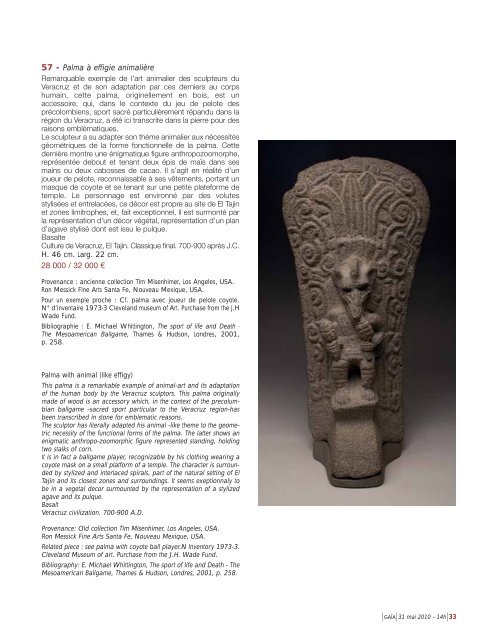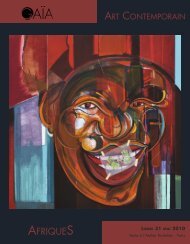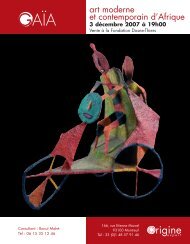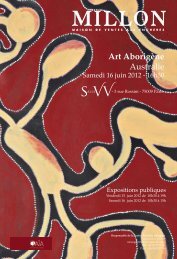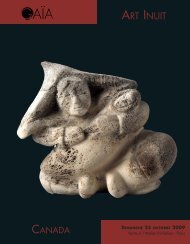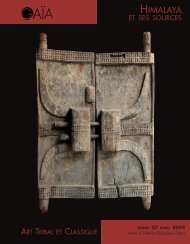catalogue - Gaia
catalogue - Gaia
catalogue - Gaia
Create successful ePaper yourself
Turn your PDF publications into a flip-book with our unique Google optimized e-Paper software.
57 - Palma à effigie animalière<br />
Remarquable exemple de l’art animalier des sculpteurs du<br />
Veracruz et de son adaptation par ces derniers au corps<br />
humain, cette palma, originellement en bois, est un<br />
accessoire, qui, dans le contexte du jeu de pelote des<br />
précolombiens, sport sacré particulièrement répandu dans la<br />
région du Veracruz, a été ici transcrite dans la pierre pour des<br />
raisons emblématiques.<br />
Le sculpteur a su adapter son thème animalier aux nécessités<br />
géométriques de la forme fonctionnelle de la palma. Cette<br />
dernière montre une énigmatique figure anthropozoomorphe,<br />
représentée debout et tenant deux épis de maïs dans ses<br />
mains ou deux cabosses de cacao. Il s’agit en réalité d’un<br />
joueur de pelote, reconnaissable à ses vêtements, portant un<br />
masque de coyote et se tenant sur une petite plateforme de<br />
temple. Le personnage est environné par des volutes<br />
stylisées et entrelacées, ce décor est propre au site de El Tajin<br />
et zones limitrophes, et, fait exceptionnel, il est surmonté par<br />
la représentation d'un décor végétal, représentation d’un plan<br />
d’agave stylisé dont est issu le pulque.<br />
Basalte<br />
Culture de Veracruz, El Tajin. Classique final. 700-900 après J.C.<br />
H. 46 cm. Larg. 22 cm.<br />
28 000 / 32 000 €<br />
Provenance : ancienne collection Tim Misenhimer, Los Angeles, USA.<br />
Ron Messick Fine Arts Santa Fe, Nouveau Mexique, USA.<br />
Pour un exemple proche : Cf. palma avec joueur de pelote coyote.<br />
N° d’inventaire 1973-3 Cleveland museum of Art. Purchase from the J.H<br />
Wade Fund.<br />
Bibliographie : E. Michael Whittington, The sport of life and Death -<br />
The Mesoamerican Ballgame, Thames & Hudson, Londres, 2001,<br />
p. 258.<br />
Palma with animal (like effigy)<br />
This palma is a remarkable example of animal-art and its adaptation<br />
of the human body by the Veracruz sculptors. This palma originally<br />
made of wood is an accessory which, in the context of the precolumbian<br />
ballgame -sacred sport particular to the Veracruz region-has<br />
been transcribed in stone for emblematic reasons.<br />
The sculptor has literally adapted his animal -like theme to the geometric<br />
necessity of the functional forms of the palma. The latter shows an<br />
enigmatic anthropo-zoomorphic figure represented standing, holding<br />
two stalks of corn.<br />
It is in fact a ballgame player, recognizable by his clothing wearing a<br />
coyote mask on a small platform of a temple. The character is surrounded<br />
by stylized and interlaced spirals, part of the natural setting of El<br />
Tajin and its closest zones and surroundings. It seems exeptionnaly to<br />
be in a vegetal decor surmounted by the representation of a stylized<br />
agave and its pulque.<br />
Basalt<br />
Veracruz civilization. 700-900 A.D.<br />
Provenance: Old collection Tim Misenhimer, Los Angeles, USA.<br />
Ron Messick Fine Arts Santa Fe, Nouveau Mexique, USA.<br />
Related piece : see palma with coyote ball player.N Inventory 1973-3.<br />
Cleveland Museum of art. Purchase from the J.H. Wade Fund.<br />
Bibliography: E. Michael Whittington, The sport of life and Death - The<br />
Mesoamerican Ballgame, Thames & Hudson, Londres, 2001, p. 258.<br />
I GAÏA I 31 mai 2010 - 14h I 33


